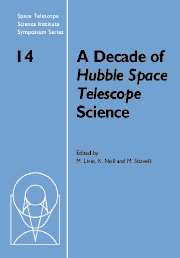Book contents
- Frontmatter
- Contents
- Participants
- Preface
- HST studies of Mars
- HST images of Jupiter's UV aurora
- Star formation
- SN1987A: The birth of a supernova remnant
- Globular clusters: The view from HST
- Ultraviolet absorption line studies of the Galactic interstellar medium with the Goddard High Resolution Spectrograph
- HST's view of the center of the Milky Way galaxy
- Stellar populations in dwarf galaxies: A review of the contribution of HST to our understanding of the nearby universe
- The formation of star clusters
- Starburst galaxies observed with the Hubble Space Telescope
- Supermassive black holes
- The HST Key Project to measure the Hubble Constant
- H0 from Type Ia supernovae
- Strong gravitational lensing: Cosmology from angles and redshifts
Supermassive black holes
Published online by Cambridge University Press: 13 August 2009
- Frontmatter
- Contents
- Participants
- Preface
- HST studies of Mars
- HST images of Jupiter's UV aurora
- Star formation
- SN1987A: The birth of a supernova remnant
- Globular clusters: The view from HST
- Ultraviolet absorption line studies of the Galactic interstellar medium with the Goddard High Resolution Spectrograph
- HST's view of the center of the Milky Way galaxy
- Stellar populations in dwarf galaxies: A review of the contribution of HST to our understanding of the nearby universe
- The formation of star clusters
- Starburst galaxies observed with the Hubble Space Telescope
- Supermassive black holes
- The HST Key Project to measure the Hubble Constant
- H0 from Type Ia supernovae
- Strong gravitational lensing: Cosmology from angles and redshifts
Summary
One of the important topics of current astrophysical research is the role that supermassive black holes play in shaping the morphology of their host galaxies. There is increasing evidence for the presence of massive black holes at the centers of all galaxies and many efforts are directed at understanding the processes that lead to their formation, the duty cycle for the active phase and the question of the fueling mechanism. Related issues are the epoch of formation of the supermassive black holes, their time evolution and growth and the role they play in the early ionization of the Universe. Considerable observational and theoretical work has been carried out in this field over the last few years and I will review some of the recent key areas of progress.
Introduction
It is now widely accepted that quasars (QSOs) and Active Galactic Nuclei (AGN) are powered by accretion onto massive black holes. This has led to extensive theoretical and observational studies to elucidate the properties of the black holes, the characteristics of the accretion mechanisms and the mechanisms responsible for the production and transportation of the energy from the central regions to the extended radio lobes.
However, over the last few years there has been an increasing realization that Massive Dark Objects (MDOs) may actually reside at the centers of all galaxies (Ho 1998, Magorrian et al. 1998, Richstone et al. 1998, Gebhardt et al. 2000a, Gebhardt et al. 2000b, Merrit & Ferrarese 2001, van der Marel 1999).
- Type
- Chapter
- Information
- A Decade of Hubble Space Telescope Science , pp. 198 - 213Publisher: Cambridge University PressPrint publication year: 2003

